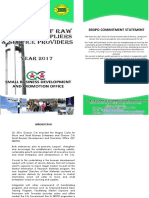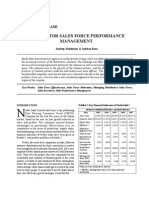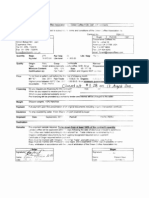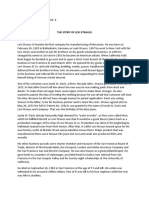Synopsis
Uploaded by
Alex KuriakoseSynopsis
Uploaded by
Alex KuriakoseRELIANCE BAKING SODA: OPTIMIZING PROMOTIONAL SPENDING Analysis by Group 1 (Anvesh, Sameer, Rajat, Alex, Arun) OBJECTIVE Reliance
e Baking Soda is Stewart Corporation's oldest and most established product. The new Domestic Brand Director needs to create a 2008 marketing budget that delivers a profit increase of 10% over 2007 levels. She must first evaluate the effectiveness of past consumer and trade promotions and determine if a price increase will have net bottom line benefits. Then she must decide on the optimal allocation of her marketing budget, taking into account the brand's apparent "cash cow" role in the Household Division of Stewart Corporation. The following approaches need to be adopted 1. Evaluate the respective roles of price, advertising, consumer promotion, and trade promotion in marketing a mature product. 2. Develop quantitative analysis skills needed to evaluate consumer and trade promotion expenditures. 3. Explore different approaches to marketing expenditure allocations and consider the implications of those decisions. Specific Inferences& facts from the case: 1. RBS has 95% brand awareness & 70% market capture. 2. A price rise in baking soda doesnt affect its demand significantly. 3. 40% people have more than one box of baking soda at home this implies that when required, people dont simply search around and just go & purchase a fresh box. 4. In case of ads RBS ads not remembered & are insignificant in communicating or pushing the sales. 5. Sales dependency on trade promotions is huge; secondly in 2006 a lot of efforts made in this foray and impact can be seen clearly in rise of profits to $15,815 even when marketing expenses rose by whopping 52%. 6. Point of purchase an ad plays a major role in creating a desire to go in for a purchase and is a cost-effective method too to boost sales. Moreover ads can be used at specific places like grocery stores and warehouse club where sales contribution is most. SWOT Analysis STRENGTHS 1. 95% brand awareness 2. Market share of 70% 3. Substitute for higher priced household cleaning products 4. Consistent demand throughout the year. OPPURTUNITIES 1. New uses of baking soda can be investigated. 2. Minimum advertising expenditure required 1. 2. 3. 4. 1. 2. 3. 4. WEAKNESSES Requires lot of push marketing Perceived to be a boring product Promotions not performance based 73% of factory sales happen during trade promotions. THREATS Price increase of 13% Private label eating into market share Cannibalization of baking soda by other household products High inventory in stores from 2006 promotions.
Alternative Strategies:
1. It is seen that trade promotions and consumer promotions take place simultaneously throughout the year. In
2006 promotions took place for 193 days in the year. This resulted for 73% of the sales. The remaining 172 days accounted for only 27% of sales from the factory. If trade promotions are given during 127 days when
there are no, consumer promotions the retailers will push the product into the market since the promotions are incentive based. Also, consumer promotions can be given for the remaining 172 days of the year when there are no trade promotions. This will result in a pull from the consumer side and increase sales. Thus, now there would be better sales throughout the year and an increase in volume. 2. There is only a 20% brand recall through advertising, still there seems to be 95% brand awareness. Hence there could be a reduction in the advertising budget. This can help divert funds for the new products launch.
Proposed Budget for 2008
Manufacturer's Price per case 8 oz 1 lb 5 lb Factory Shipments (in 000s of cases) 8 oz 1 lb 5 lb Variable Manufacturing Cost Per case 8 oz 1 lb 5 lb Gross Sales Variable Manufacturing Costs Gross Margin $ $ $ 2005 6.18 10.33 46.63 $ $ $ 2006 6.37 10.64 48.03 $ $ $ 2007E 7.20 12.02 54.28 % Change from 2006 13% 13% 13% $ $ $ 2008 7.20 12.02 54.28 % Change from 2007 0% 0% 0%
640 1099 581
793 1362 720
714 1226 648
-10% -10% -10%
714 1430 630
0% 15% -3%
$ 3.02 $ 4.98 $ 22.12 $ 42,399.90 $ 20,257.54 $ 22,142.36 52%
$ 3.05 $ 5.03 $ 22.34 $ 54,124.69 $ 25,354.31 $ 28,770.38 53%
$ 3.38 $ 5.58 $ 24.80 $ 55,050.76 $ 25,324.80 $ 29,725.96 54%
11% 11% 11% 2% 0% 3% 2%
$ 3.38 $ 5.58 $ 24.80 $ 56,525.80 $ 26,016.72 $ 30,509.08 54%
0% 0% 0% 3% 3% 3%
Advertising TV Print Internet Total Advertising PR/Media Production Costs Consumer Promotion Trade Promotion Total Marketing expenses Profit before SGA, Overheads & Taxes
$ 2,862.00 $ 687.00 $ 76.00 $ 3,625.00 $ 191.00
$ 4,453.00 $ 950.00 $ 238.00 $ 5,641.00 $ 297.00
$ 3,815.00 $ 694.00 $ 248.00 $ 4,757.00 $ 198.00
-14% -27% 4% -16% -33% -49% -7% -15% 18%
$ 3,500.00 $ 665.00 $ 200.00 $ 4,365.00 $ 148.00
-7% -3% -20% -7% -17% 50% -15% -6%
$ 424.00 $ 4,240.00 $ 8,480.00 $ 13,662.36 32%
$ 1,080.00 $ 5,938.00 $ 12,956.00 $ 15,814.38 29%
$ 551.00 $ 5,505.00 $ 11,011.00 $ 18,714.96 34%
$ 1,090.00 $ 4,600.00 $ 10,203.00 $ 20,306.08 36%
10%
You might also like
- L'oreal Masters Multiculturalism (Group 5)No ratings yetL'oreal Masters Multiculturalism (Group 5)9 pages
- Population Services International: The Social Marketing Project in BangladeshNo ratings yetPopulation Services International: The Social Marketing Project in Bangladesh7 pages
- Blue Mountain Coffee ADBUDG ME For Excel Case Version 1.0.5100% (1)Blue Mountain Coffee ADBUDG ME For Excel Case Version 1.0.58 pages
- Reliance Baking Soda Optimizing Promotional SpendingNo ratings yetReliance Baking Soda Optimizing Promotional Spending3 pages
- Learnings From Coffee Wars in India - 20021141085 - PushpakSinghalNo ratings yetLearnings From Coffee Wars in India - 20021141085 - PushpakSinghal1 page
- Wilkerson Company Case Numerical Approach SolutionNo ratings yetWilkerson Company Case Numerical Approach Solution3 pages
- Gef India Private Limited: 2010 Launching A New Brand of Edible Oil Case StudyNo ratings yetGef India Private Limited: 2010 Launching A New Brand of Edible Oil Case Study4 pages
- Harley-Davidson: Chasing A New Generation of Customers: About The Company and CaseNo ratings yetHarley-Davidson: Chasing A New Generation of Customers: About The Company and Case1 page
- Written By-Sandeep Puri Archit Khaker Shreya GuptaNo ratings yetWritten By-Sandeep Puri Archit Khaker Shreya Gupta9 pages
- Reed Supermarkets: A New Wave For CompetitorsNo ratings yetReed Supermarkets: A New Wave For Competitors46 pages
- Making A Tough Personnel Decision at Nova Waterfront Hotel: Case AnalysisNo ratings yetMaking A Tough Personnel Decision at Nova Waterfront Hotel: Case Analysis9 pages
- Sharma Industries (SI) : Structural Dilemma: Group No - 2No ratings yetSharma Industries (SI) : Structural Dilemma: Group No - 25 pages
- Ferns N Petals Flowering Through A Unique Franchising Model SWOT AnalysisNo ratings yetFerns N Petals Flowering Through A Unique Franchising Model SWOT Analysis8 pages
- Supply Chain Management at World Co PPT Slides100% (1)Supply Chain Management at World Co PPT Slides16 pages
- Case Analysis On BMW Z3 Roadster - 150103062No ratings yetCase Analysis On BMW Z3 Roadster - 1501030626 pages
- Clique Pens: The Writing Implements Division of U.S. Home: Consumer-Oriented MDF100% (1)Clique Pens: The Writing Implements Division of U.S. Home: Consumer-Oriented MDF1 page
- Merchandising: Anjali / Devjyoti / Pooja / Riya / Sachin / SakinaNo ratings yetMerchandising: Anjali / Devjyoti / Pooja / Riya / Sachin / Sakina67 pages
- Reliance Baking Soda Case: Group 2 Ashlay Kalra Gaurav Raj Saurabh Mantri Jatin Sadana Anshul Jain Abhishek Shetty PaulNo ratings yetReliance Baking Soda Case: Group 2 Ashlay Kalra Gaurav Raj Saurabh Mantri Jatin Sadana Anshul Jain Abhishek Shetty Paul15 pages
- Premium ReadyMade Soft Silk Panchakacham+Kurta+Towel Set Trinethra PDFNo ratings yetPremium ReadyMade Soft Silk Panchakacham+Kurta+Towel Set Trinethra PDF1 page
- Comparative Study Among Parle, Perfetti, Britannia & HLLNo ratings yetComparative Study Among Parle, Perfetti, Britannia & HLL3 pages
- Management of Sales Territories and Quotas: SDM-Ch.4 1No ratings yetManagement of Sales Territories and Quotas: SDM-Ch.4 115 pages

























































































